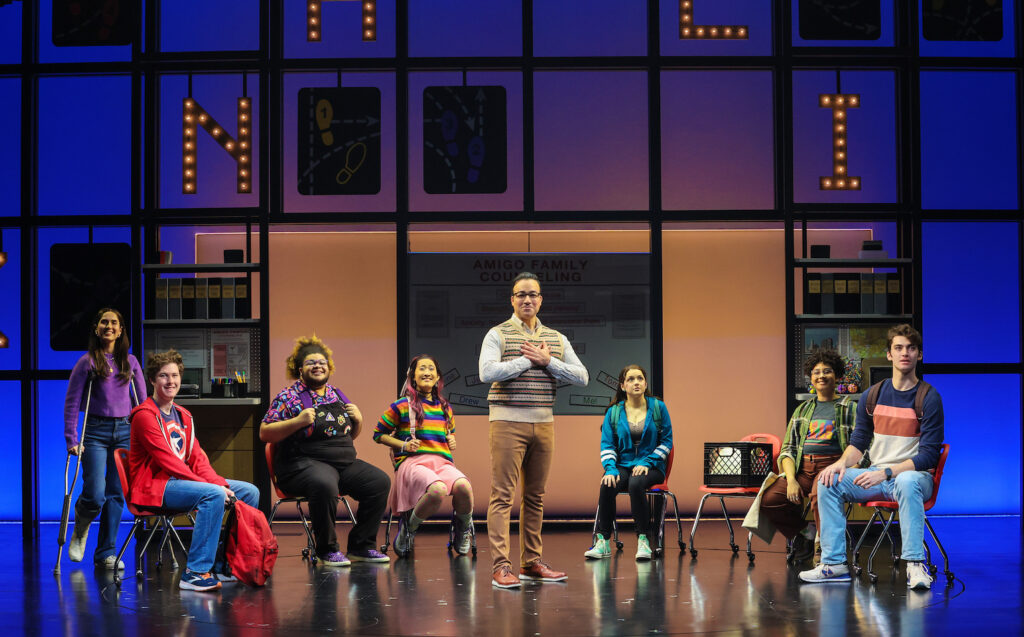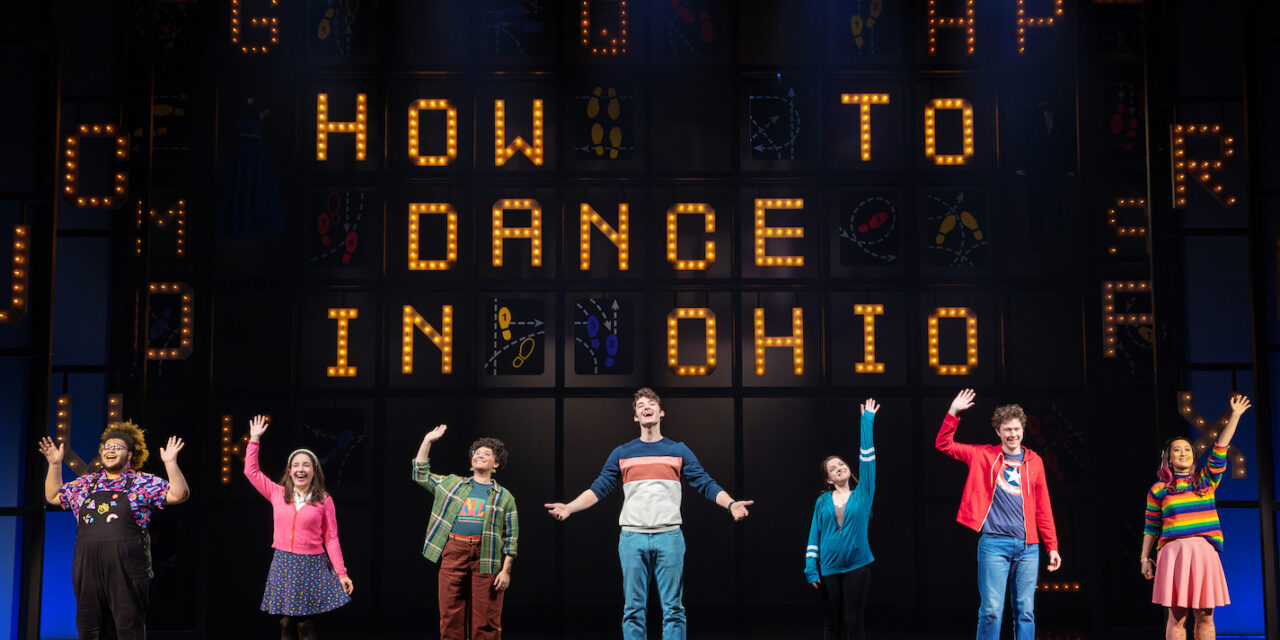Theater Review by Carole Di Tosti . . . .
Based on Alexandra Shiva’s titular documentary film, the trailblazing musical How to Dance in Ohio is uplifting and endearing with vital thematic points tucked away in song lyrics that may be too easily overlooked. With book and lyrics by Rebekah Greer Melocik and music by composer-collaborator Jacob Yandura, the light-hearted production directed by Sammi Cannold currently runs at the Belasco Theatre with one intermission.
Though the structure and integration of music, lyrics, and book are not unique, the immensely talented cast, seven principals with superb voices, verve, and authenticity, are mavericks. Before the musical begins, they introduce themselves as uniquely individual. Each is autistic. However, as the character Tommy (Conor Tague) says, “If you’ve met one autistic person . . . you’ve met one autistic person.”

As the import of his statement flies over the audience’s heads, the introduction to seven autistic persons, who appear for the first time in Broadway history, intrigues. Then the talented actors take their places, and the literal and metaphoric story unspools. And we understand how “the seven,” their parents, their counselor Dr. Amigo, and his daughter Ashley, learn how to “dance” in Ohio.
Of course, “dance” is also a metaphor for evolving, growing, learning, failing, getting up and trying once more, apologizing, and forgiving oneself and others. Ultimately, this extraordinary musical is about loving, seeing, and accepting others for who they are, as best as one can.
When Drew (Liam Pearce), who has been accepted at the University of Michigan, expresses his doubts about the unfamiliarity of being in a different state away from home in completely new surroundings, Dr. Amigo (Caesar Samayoa), who heads up a counseling center that the seven young adults attend, sees an opportunity. He suggests that they hold a formal dance as a therapy tool to help Drew and the others feel more comfortable in challenging social situations.
During the next months, they prepare for the special event, practicing etiquette rules, reinforcing social skills, buying outfits, finding dates, and learning how to dance. It is during this process we “see” each character and become familiar with their viewpoints and stresses about the conflict between abled and “disabled,” as well as their interests in their personal lives. Importantly, the process massages us to embrace the musical’s message which is grounded in common sense. Personality and individuality are unqualifiable and unquantifiable. The moment one uses limitations to define others, it leads to misapprehension and confusion. Categories of “normalcy” that put people in boxes (reflected in Robert Brill’s fine set design of a grid of rectangles), must be shattered.


The exceptional cast and the creative team, who convey the director’s vision, importantly break through audience assumptions and stereotypes about individuals with autism and turn them on their heads. During the musical, we note that assumptions not only nullify but also oppress and stultify creativity.
These themes are intimated throughout and initiated in the opening numbers “Today Is” and “Under Control.” Additionally, in “The How-To’s” we learn that the parents and adults are continually learning how to negotiate the circumstances that arise in their relationships with their children. With these songs we meet Remy (Desmond Luis Edwards), Caroline (Amelia Fei), Marideth (Madison Kopec), Drew (Liam Pearce), Mel (Imani Russell), Tommy, and Jessica (Ashley Wool). We learn about their concerns in “getting everything right,” and negotiating a world which, in its most uneducated, crass, and ignorant fashion, “treats” them as “the other.”
Melocik’s lyrics reveal each individual’s desires, fears, talents, and brilliance. Her striking songs resonate with metaphors and sage perspectives. For example, we discover that Pearce’s Drew, who has been accepted at the University of Michigan, reflects the stress he is under when he says he must “be the poster child; for if he can, then you can.” This is a noxious presumption echoed by Remy in “Nothing at All,” when he asks the question, “Do I only exist on this planet to make somebody else feel inspired?” And Remy brings up being looked upon as an “object of pity,” suggesting, “if that is what you see, then clearly you aren’t seeing me.”


In “Unlikely Animals,” Marideth sits with her father in a diner discussing the unusual animals, geography, and climate of Australia to avoid discussing the dance. In pointing out Australian fauna that is unique to the world, she underscores the irony that Australia is, “a lesson in what isolation and distance can do. A land of unlikely animals so strange they couldn’t possibly be true.” As Marideth finishes the discussion with her father, she says that Australia reveals “the evidence that what we call nature is not always normal.” The parallel she draws with herself emphasizes that diversity is vital to our understanding of life’s wonders and should be accepted.
Songs like these, and “Waves and Wires,” “Drift,” and Drew’s “Building Momentum” are standouts amidst others that serve to move along the plot but don’t necessarily distill the heart of the musical’s themes.
Thus, despite the angst and a disagreement between daughter Ashley (Cristina Sastre) and Dr. Amigo, everyone seems to be ready for their big night, “The Amigo Spring Formal.” Then, a disastrous conflict occurs when the event gets attention from the press and becomes mischaracterized, emphasizing “the good” Dr. Amigo is doing. The typical ableist response objectifying “the autistic” destroys the fun and blows up everything so only one person shows up to the dance.
How the circumstances are resolved requires accountability, forgiveness, and love, for a satisfying conclusion in “The Second Chance Dance” and “Finale.”
Praise goes to the creatives for this must-see, novel production.
How to Dance in Ohio. Open run at the Belasco Theatre (111 West 44 Street, between Sixth and Seventh Avenues). www.howtodanceinohiomusical.com
Photos: Curtis Brown


















